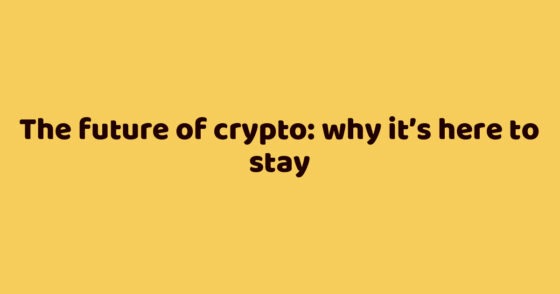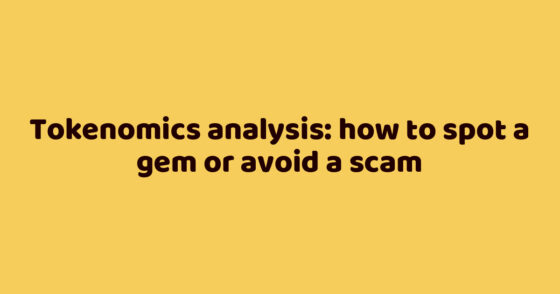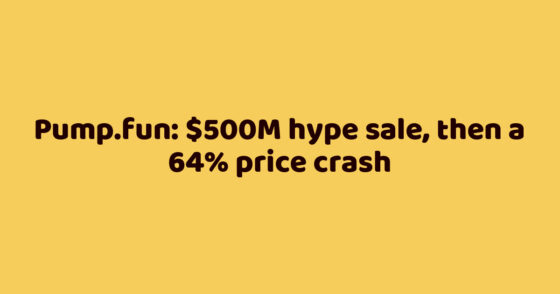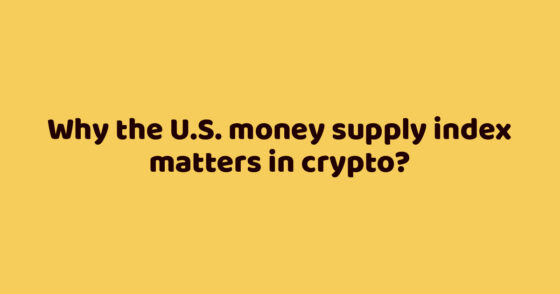Decentralized finance lacks simplicity. It’s difficult for non-Web3 people to interact with DeFi protocols and deal with liquidity, staking returns, and complex trading strategies.
To simplify interaction for novices and improve the crypto-financier experience, developers turned to AI. This is how the DeFAI story was born.
What is AI for in DeFi applications?
Decentralized finance in its current form has the potential to become a worthy alternative to the current financial system and take a place in the international economy. One of the challenges to mass adoption of cryptocurrencies and DeFi remains the complexity of the technology.
Many users, accustomed to the intuitive interface of modern applications, do not want to delve into the intricacies of blockchain protocols and understand the structure of decentralized finance. So how can they benefit from DeFi? The developers attempted to answer this question by implementing network abstraction (NA) technology, which includes the more common account abstraction (AAU).
With the help of AI, financial app developers are implementing simplifications to lower the user experience (UX) threshold as much as possible. This approach has become an element of a new narrative – DeFAI (DeFi + AI). The symbiosis aims to remove barriers by providing a simple, customized interface for decentralized applications.
For advanced crypto financiers, DeFAI offers an improved user interface (UI) and increased profits through the use of sophisticated trading strategies and on-chain analytics.
Coupled with AI, several features have been added to the dapps:
- Risk management – identifying potential threats to profit or capital loss and minimizing the consequences;
- Automated trading. Algorithms analyze market patterns and execute trades independently;
- Fraud prevention through intelligent detection systems;
- Profit optimization. Strategies seek to maximize profits by interacting with multiple protocols and selecting the most profitable ones.
AI Agents Have Created and Occupied a Niche
AI agents make up the bulk of dapps in the DeFAI category. The sector of such bots has slowed down significantly since the boom at the end of 2024. And although in early February 2025 the Binance exchange tried to draw attention to them, this did not help tokens of popular projects to recover after a large-scale collapse.
On March 18, former platform head Changpeng Zhao urged AI developers to focus on creating useful products instead of issuing tokens.
On AI agents, I have an unpopular opinion:
While crypto is the currency for AI, not every agent needs its own token.
Agents can take fees in an existing crypto for providing a service.
Launch a coin only if you have scale. Focus on utility, not tokens.🙏
— CZ 🔶 BNB (@cz_binance) March 17, 2025
According to CryptoRank, the DeFAI story has been gaining momentum since January 2025. The chart below shows a 62.6% increase in the value of the subcategory over a 30-day period. Among the leaders were tokens in related fields: AI agents, portfolio managers and trading strategy platforms.
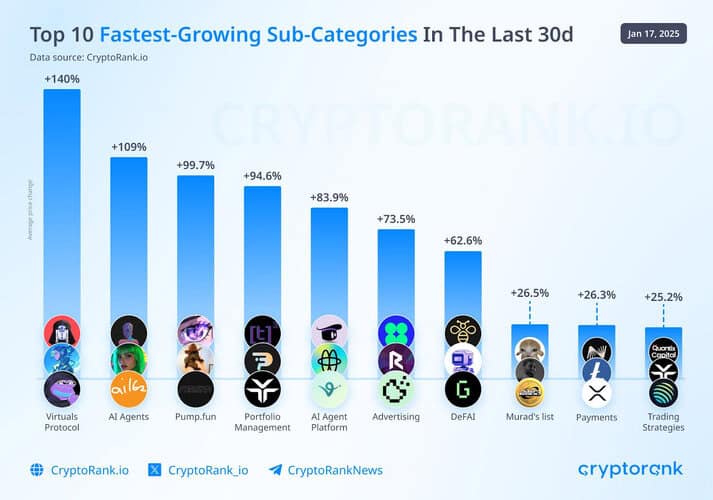
The emergence of AI agents with the ability to autonomously process transactions on the blockchain, such as Griffain and Orbit, has contributed to the DeFAI trend.
On March 17, 2025, crypto analyst Miles Deutscher noted the long-term importance of the DeFAI sector. He highlighted user engagement with the two leading categories over the past 90 days. He chose a favorite, the ANON token of the Hey Anon project, to invest in the new direction.
2 strongest sectors for mindshare over the last 90 days: DeFAI and Data.
Market has clearly shifted to utility.
Fundamentally (long term):
For DeFAI, I like $ANON.
For data, I like $GRASS & $LINK pic.twitter.com/ZLCiHkMkFz— Miles Deutscher (@milesdeutscher) March 17, 2025
AI assistants have quickly become popular due to automated features that simplify interactions with DeFi protocols. For example, Griffain-based agents can be created for token launch, SOL staking, and liquidity management.
These advances are made possible by the implementation of Trusted Execution Environments (TEE). The Phala Network protocol implements this technology and allows custom AI agents to be deployed on top of it. TEE enables operations to take place in a secure and confidential environment, protecting sensitive data from malicious attacks and improving the efficiency and reliability of operations.
Despite the bearish market sentiment, cryptocurrency experts at Sygnum Bank have given a positive outlook for AI assistant tokens in 2025. However, at the current point in the cycle, they remain predominantly speculative assets.
How DeFAI Applications Are Organized?
AU-based systems or intent-based blockchains also serve to simplify UX. In the former, users express a desired outcome and the system, often with the help of solvers, finds the best way to achieve it.
For example, when exchanging tokens or transferring assets between networks, a solver determines the best route, taking into account gas fees, slippage, and liquidity, and then executes the necessary transactions.
In the case of DeFAI, machine learning algorithms and large language models (LLMs) are used to simplify the interaction with the blockchain. Instead of focusing on the infrastructure required to execute the intent, artificial intelligence makes more informed decisions before transactions are executed.
AI agents analyze on-chain data, predict market trends, and recommend actions that align with the user’s goals. For example, selecting the best pool to provide liquidity, or optimizing asset allocation for pharming returns.
AI enhances DeFi tools. Available dapps include the following innovations:
- Personalized financial strategies. AI generates conclusions based on provided data about transaction history, investment patterns, and risk management. DeFAI apps then create personalized financial strategies. For example, it analyzes on-chain activity to highlight frequent interactions with stablecoins and then recommends high-return platforms for stacking them;
- Targeted trading. Observing short-term price fluctuations often leads to impulsive decisions. DeFAI’s applications help automate trading strategies and reduce the emotional impact. Users can set clear financial goals, such as “Sell 30% of ETH if the price falls below $1800 to minimize losses, or sell at $2500 to lock in a profit”.
- Choice of validators for staking. Improper validator selection when there are a large number of validators can result in lower payouts or even penalties. DeFAI applications analyze the sample by evaluating activity time and reputation scores;
- Text-based portfolio management. With chatbot interfaces, DeFAI dapps allow portfolio management in the form of correspondence. Some dapps integrate with Telegram and Discord messengers.
DeFAI in action
As of March 20, 2025, the capitalization of the DeFAI category in CoinGecko is close to $900,000.
Among the submitted projects are market analysis agents, trading decision assistants, infrastructure platforms for programming trading strategies, and automated investment systems.
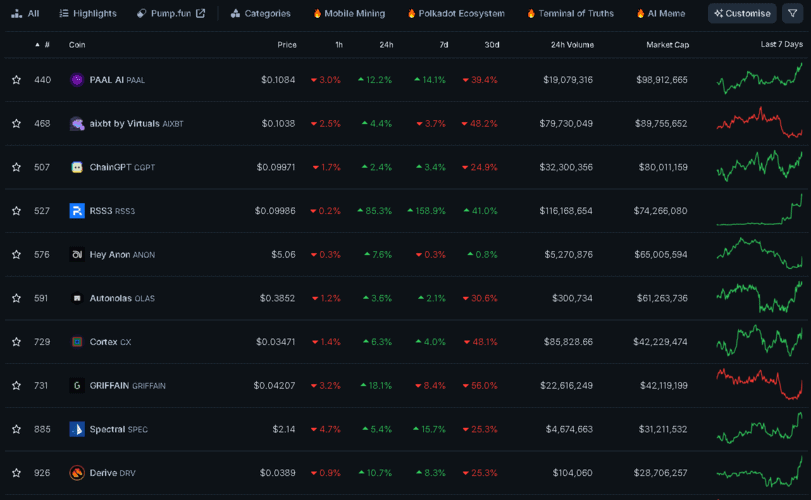
First place goes to PAAL AI, a multifunctional AI platform in the form of a chatbot.
It is followed by the popular AI agent Aixbt. This autonomous assistant is published on the Virtuals Protocol platform on the Base network. It allows you to perform fundamental analysis of cryptocurrencies, track sentiment in social networks and create a dynamic picture of the market.
The third place is occupied by ChainGPT, a startup in the field of automated trading, creation of smart contracts and NFT.
The sphere of infrastructure solutions is represented by RSS3, a project for information gathering and platforms for launching AI agents.
The fifth place in terms of capitalization is occupied by Hey Anon, the brainchild of experienced DeFi developer Daniel Sesta. The dapp collects information about projects on various blockchains and “communicates” with the user through a dialog box. The application helps to make informed decisions and fine-tune trading algorithms with stop-losses of varying complexity.
Nerding out on this a bit more here is a practical example:
Example Setup:
Entry price: $0.0010
Initial ATR (10-period, 1-minute candles): $0.0001
Initial stop-loss: Aggressive at 5× ATRBelow you can see the different stop losses at different volatility as the coin goes up. https://t.co/bsgQeRNVEI pic.twitter.com/J3qsbD1kVE
— Daniele 🟧 ( Revenge Arc ) (@danielesesta) March 17, 2025
Investment managers’ DeFAI systems are designed to assist in portfolio management:
- Aspis. The AIDAO framework allows the customization of AI agents for vaults and dynamic fund parameters;
- Mozaic Finance. AI managed income farming platform with interoperability optimizes return strategies and performs automatic reinvestment;
- Almanak. Leverages DeFi analytics and forecasting to optimize trading strategies and automatically rebalance investment portfolio assets.
Hallucinations instead of conclusions
It is important to consider that AI agents are prone to “hallucinations” when LLMs produce nonsensical or incorrect answers. Imagine that a “seizure” occurs during a token exchange. The agent overestimates the commission or transfers assets to the wrong contract address, resulting in a financial loss.
AI models are potentially vulnerable to hacking. In the context of DeFi, this can lead to loss of user funds. The massive use of AI agents in decentralized finance increases the risk of systemic failure of the entire cryptocurrency market.
The DeFi + AI synthesis provides an opportunity to rethink the relationship between autonomy and automation. Unlike intent-based network abstraction protocols, DeFAI preserves human participation by acting as an advisor rather than an executor.
The potential of DeFAI’s AI agents is only beginning to be realized. The very fact that they are always on and can independently execute an infinite number of transactions in milliseconds gives them a competitive advantage. But as with any new technology, the consequences of using AI agents are not always predictable, and users must always weigh the risks involved.

